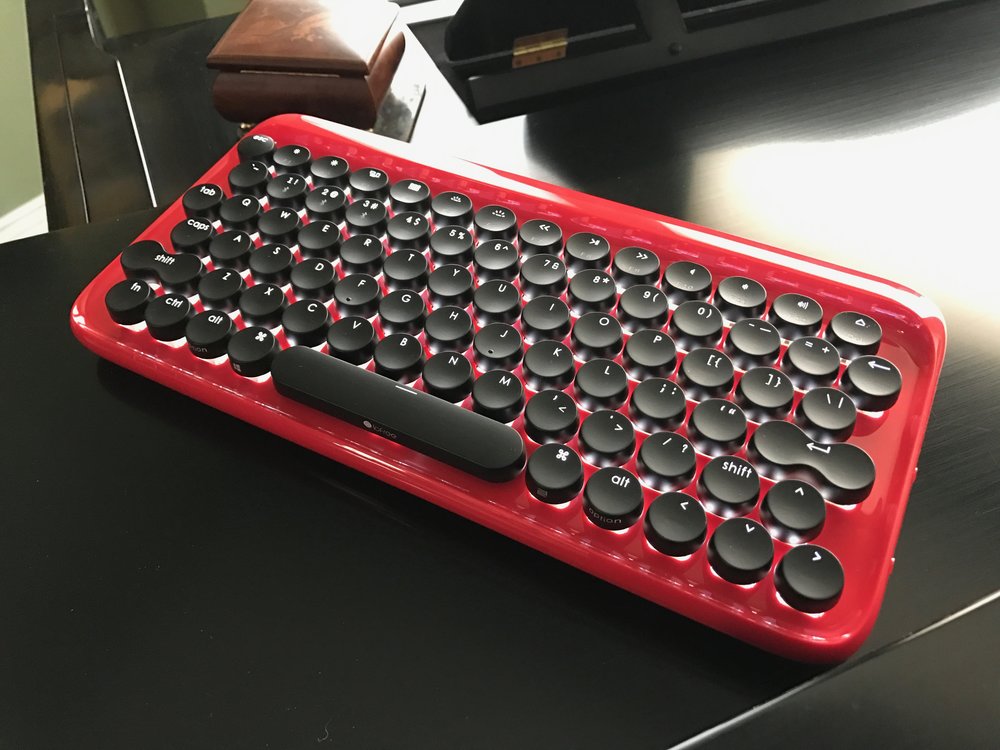
For many years, our keyboards were mechanical. You pushed a key on a typewriter which either directly pushed a letter up to the paper or triggered an electric switch to do the same. Those keyboards always had a satisfying “clackity” sound to them, and had wonderful dished key-tops that welcomed your fingertips. Today, Lofree is launching a new mechanical keyboard on Indiegogo (currently $74, will be $99 when available to the public on Amazon after May, 2017), and I was fortunate enough to get to try one out. It could easily become your favorite keyboard!
Design
The first thing that hits your eye is the design of the keyboard, which is unlike just about any other Bluetooth keyboard on the market right now. It comes in three different colors; pure white, turquoise blue (how 1960s!), and sandstone black. Oddly, I don’t see the red version I tested on the website and I think it would be very popular as it is reminiscent of the Olivetti Valentine typewriter of the 60s.
Unlike traditional computer keyboard keys, the Lofree keys are round. The shift and return keys are nice “peanut-shaped” keys with the same rounded shape, and even the space bar has rounded ends. Seriously, this keyboard could eventually end up in a design museum. It is an instant classic.
Want to use the Lofree as a wired keyboard? That’s actually what I’m going to use mine for after testing is finished, as I get Bluetooth interference problems from a Mac mini that’s near my iMac. You can use a standard USB to micro-USB cable to connect the the Lofree to the computer. Switches on the right side of the keyboard allow switching between Mac/iOS and Windows/Android setup, although the keys are definitely set up for Mac with the standard symbols we’re all used to. Don’t want Bluetooth? Shut it off (see image below).

There are two feet that prop up the Lofree so that it’s at a comfortable 6° angle for typing, and internal backlighting that can be adjusted to three different levels of brightness. You’ll be glad you have backlighting, as the markings on the keyboard are very subtle unless backlighting is enabled.
Finally, the Lofree can be paired with three different devices, so if you with to use it with a pair of Macs and an iPad (or any other combination of three), you can.
Function
The Lofree probably isn’t for everybody; if you don’t like noisy keyboards or you’ve grown up on flat keys, it’s not going to be your cup of tea. However, if you used old computer keyboards and loved both the clacking noise of the keys and the feel of those dished keycaps, you’ll love Lofree.
I found that it took me only a few minutes to get used to the feel of the Lofree. It definitely has a much different feedback than the standard Apple keyboards, and the audible feedback is quite pronounced. My old writing buddy Erica Sadun would just love this keyboard, as she’s fond of anything that makes clacking noises!
The pairing process was very simple and I was able to pair with the three devices — iMac, Mac mini and iPad Pro — with no issues. It’s quite easy to switch the keyboard between the devices by pressing Fn and the 1, 2, or 3 keys.

One thing I really love about the Lofree is that the rubber feet and weight of the device keep it in one place. If you’ve ever been pounding away on a keyboard for hours and noticed that the keyboard has “drifted” across your desk, you’ll find the Lofree’s stability to be a blessing.
The Lofree has an auto-sleep mode to help out on battery life, although most people will find the battery life with Bluetooth use to be a non-issue. Turn off the backlighting, and you can use the Lofree for about 15 months on a single charge. Bring the backlight up to 40% and you can still use it for about 1584 hours (almost 200 8-hour days); put it all the way to 100% and it will last for 720 hours (three months of 8-hour usage).
Conclusion
If you’re bored by the flat, quiet keyboards that dominate the world today, get over to Indiegogo today and be an early backer of the Lofree. The keyboards will ship in May of 2017 and should be available to the general public in an Amazon shop soon after. The excellent feel and feedback — both auditory and tactile — put the Lofree at the top of my list of keyboards I’ve tested over the past decade.
